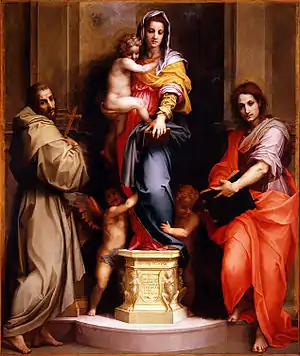Madonna of the Harpies
Madonna of the Harpies (Italian: Madonna delle Arpie) is an altarpiece in oils by Andrea del Sarto, a major painter of the High Renaissance. It was commissioned in 1515 and signed and dated by the artist in 1517 in the inscription on the pedestal; it is now in the Uffizi in Florence. It was praised by Vasari, and is arguably the artist's best-known work.
| Madonna delle Arpie (Madonna of the Harpies) | |
|---|---|
 | |
| Artist | Andrea del Sarto |
| Year | 1517 |
| Type | oil on wood |
| Dimensions | 208 cm × 178 cm (82 in × 70 in) |
| Location | Galleria degli Uffizi, Florence |
The Virgin is standing on a pedestal which includes harpies sculpted in relief, from which the painting takes its name. At least Vasari, and presumably his Florentine contemporaries, thought they were harpies; some modern art historians think that locusts are represented, in a reference to the Book of Revelation; either way they represent forces of evil being trampled on by the Virgin.[1]
It is a sacra conversazione showing the Virgin and Child flanked by putti angels and two saints (Saint Bonaventure or Francis and John the Evangelist). Compared to the stillness of earlier paintings of similar groups, here the "dynamism of the High Renaissance was inimical to the static quality of 15th-century art", so that "a composition of fundamentally classical purity is animated by a nervous energy in the figures to produce an unsettling impression of variety."[2]
It was completed in 1517 for the church of the convent and hospital of San Francesco dei Macci in Florence; this was run by the Poor Clares and is long closed, but the church building survives. The figures have a Leonardo-like aura, with a pyramid shaped composition.[3] The harpies, figures from pagan mythology (or locusts), here represent temptation and sin, which the Virgin has conquered and stands upon.[4] The Christ Child is shown as unusually old, and has an athletic contrapposto pose. He looks down to the putti, and all three have a "mischiefness" that contrasts with the serious, abstracted, air of the adults.[5]
The main character in the Kürk Mantolu Madonna ("Madonna With A Fur Coat"), a novel written by Turkish writer Sabahattin Ali, is a depiction of the Virgin Mary in Madonna of the Harpies.
References
- Google Art Project, text from Uffizi
- Nigel Gauk-Roger. "Sacra conversazione." Grove Art Online. Oxford Art Online. Oxford University Press. Web. 4 Mar. 2017. Subscription required
- John T. Paoletti, Gary M. Radke (2005). Art in Renaissance Italy. Laurence King Publishing, ISBN 978-1-85669-439-1
- Hickson, Sally Anne, Women, Art and Architectural Patronage in Renaissance Mantua, p. 34, google books
- Franklin, David, Painting in Renaissance Florence, 1500-1550, pp. 136-137, David Franklin, google books